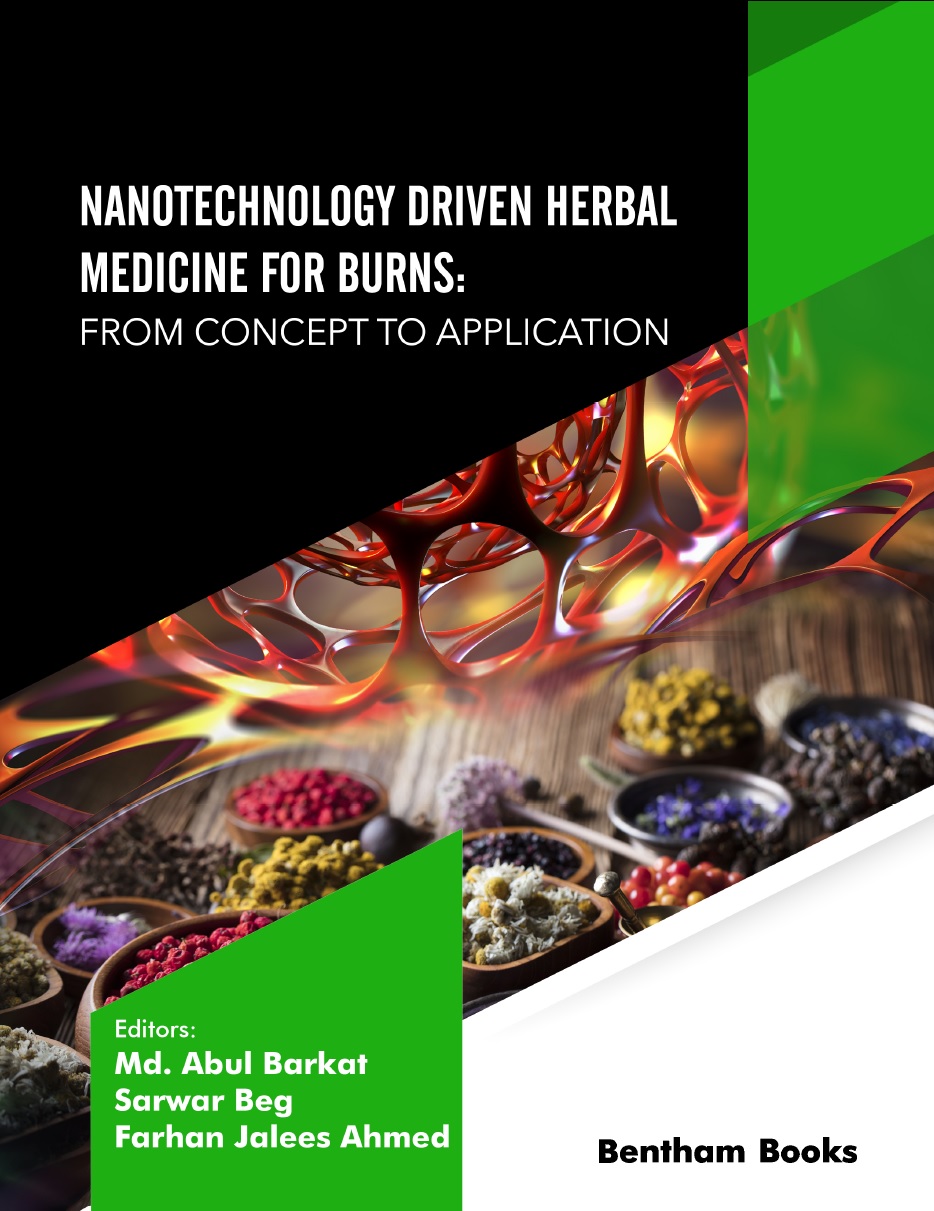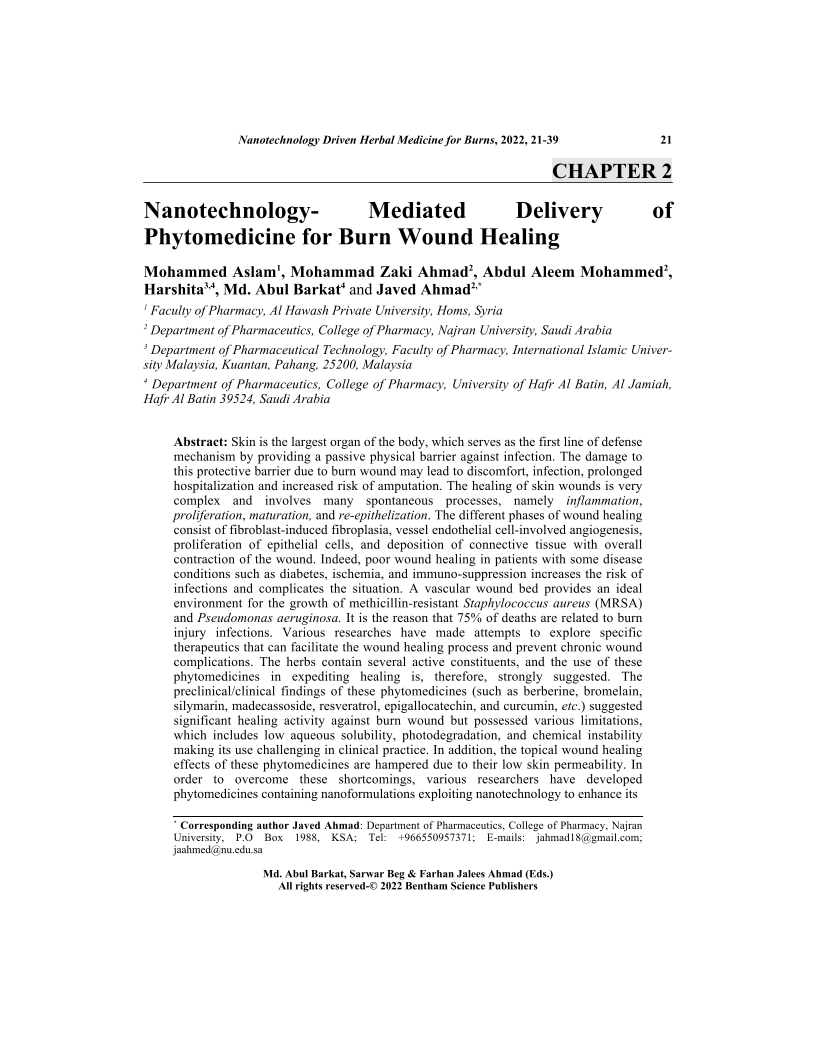Nanotechnology- Mediated Delivery of Phytomedicine for Burn Wound Healing

- Authors: Mohammed Aslam1, Mohammad Zaki Ahmad2, Abdul Aleem Mohammed3, Harshita4, Md. Abul Barkat5, Javed Ahmad6
-
View Affiliations Hide AffiliationsAffiliations: 1 Faculty of Pharmacy, Al Hawash Private University, Homs, Syria 2 Department of Pharmaceutics, College of Pharmacy, Najran University, Saudi Arabia 3 Department of Pharmaceutics, College of Pharmacy, Najran University, Saudi Arabia 4 Department of Pharmaceutical Technology, Faculty of Pharmacy, International Islamic UniversityMalaysia, Kuantan, Pahang, 25200, Malaysia Department of Pharmaceutics, College of Pharmacy, University of Hafr Al Batin, Al Jamiah, Hafr Al Batin 39524, Saudi Arabia 5 Department of Pharmaceutics, College of Pharmacy, University of Hafr Al Batin, Al Jamiah, Hafr Al Batin 39524, Saudi Arabia 6 Department of Pharmaceutics, College of Pharmacy, Najran University, Saudi Arabia
- Source: Nanotechnology Driven Herbal Medicine for Burns: From Concept to Application , pp 21-39
- Publication Date: December 2021
- Language: English
Nanotechnology- Mediated Delivery of Phytomedicine for Burn Wound Healing, Page 1 of 1
< Previous page | Next page > /docserver/preview/fulltext/9789815039597/chapter-2-1.gif
<div>Skin is the largest organ of the body, which serves as the first line of defense</div><div>mechanism by providing a passive physical barrier against infection. The damage to</div><div>this protective barrier due to burn wound may lead to discomfort, infection, prolonged</div><div>hospitalization and increased risk of amputation. The healing of skin wounds is very</div><div>complex and involves many spontaneous processes, namely inflammation,</div><div>proliferation, maturation, and re-epithelization. The different phases of wound healing</div><div>consist of fibroblast-induced fibroplasia, vessel endothelial cell-involved angiogenesis,</div><div>proliferation of epithelial cells, and deposition of connective tissue with overall</div><div>contraction of the wound. Indeed, poor wound healing in patients with some disease</div><div>conditions such as diabetes, ischemia, and immuno-suppression increases the risk of</div><div>infections and complicates the situation. A vascular wound bed provides an ideal</div><div>environment for the growth of methicillin-resistant Staphylococcus aureus (MRSA)</div><div>and Pseudomonas aeruginosa. It is the reason that 75% of deaths are related to burn</div><div>injury infections. Various researches have made attempts to explore specific</div><div>therapeutics that can facilitate the wound healing process and prevent chronic wound</div><div>complications. The herbs contain several active constituents, and the use of these</div><div>phytomedicines in expediting healing is, therefore, strongly suggested. The</div><div>preclinical/clinical findings of these phytomedicines (such as berberine, bromelain,</div><div>silymarin, madecassoside, resveratrol, epigallocatechin, and curcumin, etc.) suggested</div><div>significant healing activity against burn wound but possessed various limitations,</div><div>which includes low aqueous solubility, photodegradation, and chemical instability</div><div>making its use challenging in clinical practice. In addition, the topical wound healing</div><div>effects of these phytomedicines are hampered due to their low skin permeability. In</div><div>order to overcome these shortcomings, various researchers have developed</div><div>phytomedicines containing nanoformulations exploiting nanotechnology to enhance its cutaneous bioavailability and augment wound healing activity. This book chapter aims</div><div>to overview the various phytomedicines, their nanoformulations design and</div><div>applicability in various forms to enhance the bioavailability/efficacy in burn wound</div><div>healing.</div>
-
From This Site
/content/books/9789815039597.chapter-2dcterms_subject,pub_keyword-contentType:Journal105

